SPACE May 2022 (No. 654)
Weighing Up the Future of the Hilton Hotel
On 8th April, a symposium was held under the theme of ‘The Future of the Namsan Hilton Hotel and the Yangdong Improvement District’ at the Seoul Hall of Urbanism & Architecture. The event, co-hosted by nine institutions including SPACE, the Society of Korean Modern Architecture & Urbanism, the Korea Institute of Registered Architects, the Korea Architects Institute, OPENHOUSE Seoul, WIDE AR, Junglim Foundation, the Korean Institute of Architects, and the Korea Association for Architectural History, attracted many people to both the venue and the live broadcast on YouTube, confirming a heightened public interest in the preservation and use of modern and contemporary urban buildings such as the Hilton Hotel. Here, SPACE publishes not only the findings of the symposium, but also the position taken by IGIS Asset Management who purchased the Hilton Hotel, in order to deliver the full picture to our readers.
Symposium: The Future of the Namsan Hilton Hotel and the Yangdong Improvement District
Last year, when the sale of the Namsan Hilton Hotel designed by Kimm Jong-soung (honorary president, SAC International) to IGIS Asset Management, and the subsequent demolition and replacement project through new buildings was announced, discussions about the preservation and use of the Hilton Hotel were ignited throughout the architecture world. A symposium was proposed, ‘The Future of the Namsan Hilton Hotel and the Yangdong Improvement District’ to discuss the direction and possibility of progressive change in the area from the Hilton Hotel to the Seoul Station to the Namsan Mountain. Hwang Doojin (principal, Doojin Hwang Architects), chair of the symposium, opened the proceedings, noting ‘Instead of taking the dichotomous approach to development or conservation, letʼs go where no man has gone before, and explore new possibilities of which no one has yet conceived’.
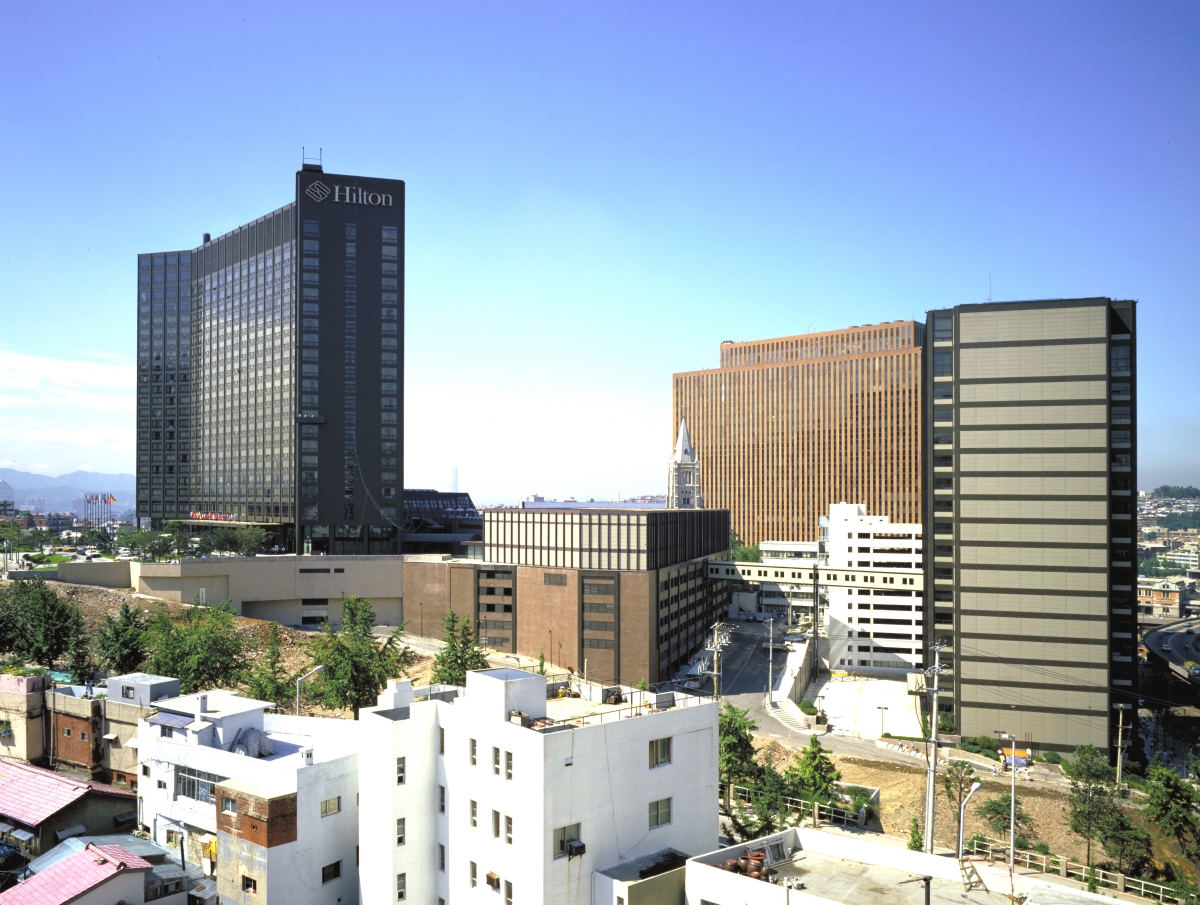
Image courtesy of Art Research Center, National Museum of Modern and Contemporary Art, Korea (Donated by Kimm Jong-soung)
The Social Status and Architectural Value of the Hilton Hotel
Pai Hyungmin (professor, University of Seoul) began his presentation ‘Architecture of the Hilton Hotel: A Milestone in Korea of the Late 20th Century’ with the statement that a hotel is a symbol typical of modernity. From the perspective of hotel history in Korea, the Chosun Hotel and the Bando Hotel built during the Japanese colonial period represent the first phase, while the Hilton Hotel was built at the end of the second phase when large hotels were constructed to promote tourism as a national strategic industry from the mid-1970s. In other words, the building marks an important moment at which Koreaʼs economy shifted from government-led development to an emphasis on the accumulation of private capital. He explained that Kimm Jong-soung, who studied under Mies van der Rohe, introduced the dry construction method to Korea where only wet construction had previously been available. The Hilton Hotel is the finest project among these early examples. He argued that details in the Hilton Hotel have the value of a unique cultural heritage site that can never be reproduced, as it is impossible to find the same materials and level of craftsmanship. The aluminum used on the exterior mullions has significance in the history of Korean architecture in that they were made using an aluminum extrusion moulding technology of a Korean manufacturer in consultation with an overseas company, unlike before, when they were typically imported. In addition, although Miesʼs works have been designated as cultural heritage sites worldwide, the Hilton Hotel has a unique meaning in the history of world architecture in that no other iron mullion-style details remain. Pai concluded his presentation with a strong question—is there any branding that can exceed the existing valuable assets, no matter how much of the budget is invested in branding and marketing a new building on the site of the Hilton Hotel.
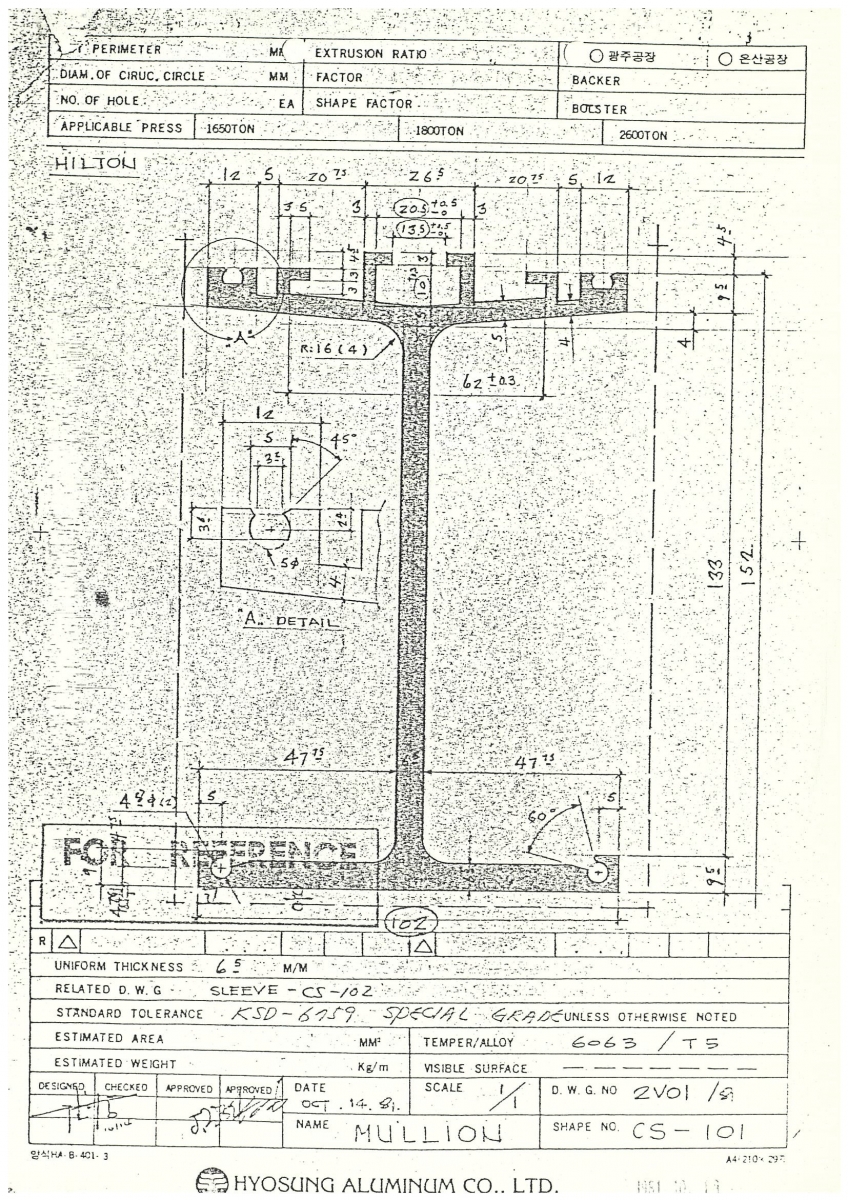
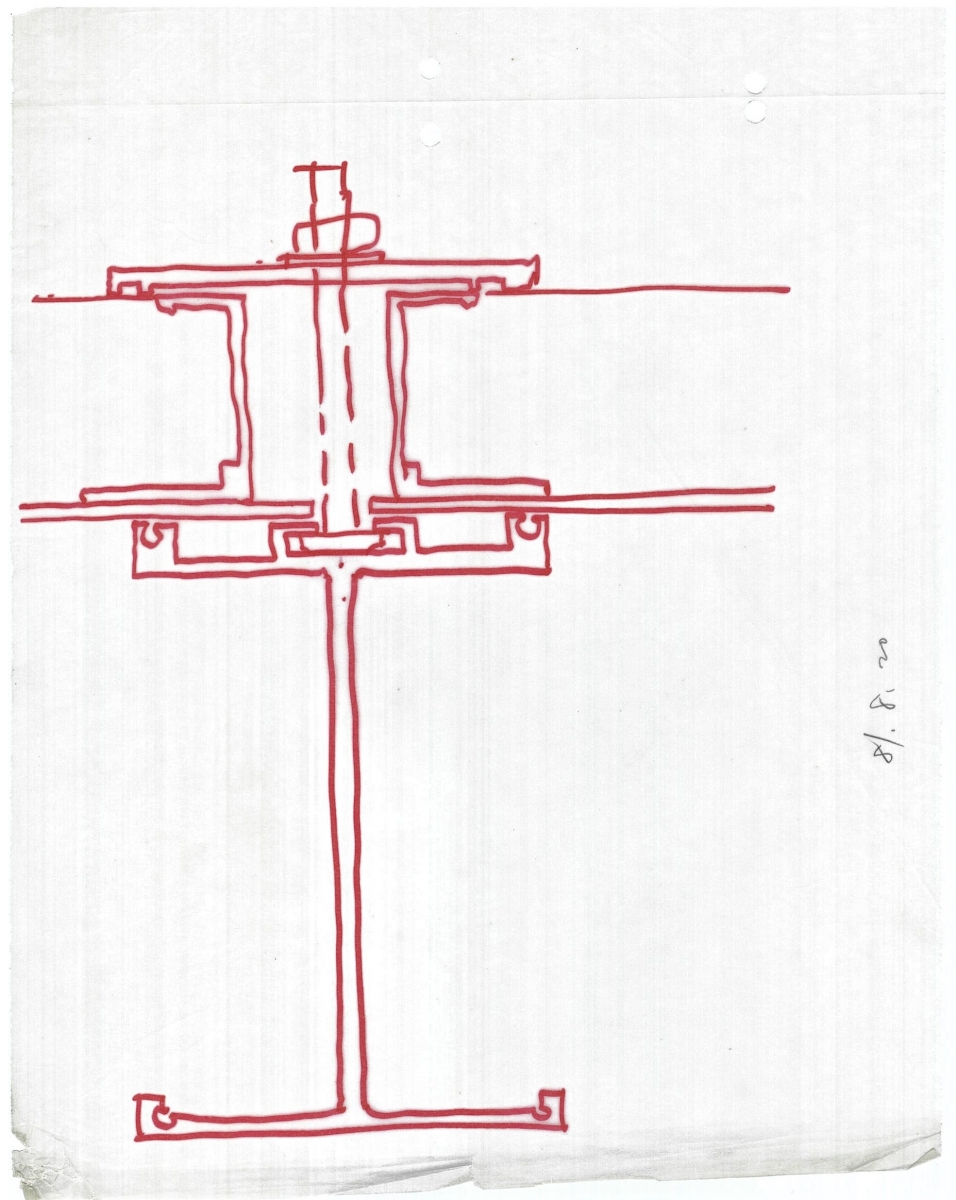
Images courtesy of Art Research Center, National Museum of Modern and Contemporary Art, Korea (Donated by Kimm Jong-soung)
The Future of the Hilton Hotel as a Redevelopment Project
The presentation by Lee Kwanghwan (principal, HAEAHN Architecture), ‘Future of the Hilton Hotel and the Current State of Redevelopment and Improvement Plan’ followed, expanding the perspective to the Yangdong Redevelopment District within which the Hilton Hotel stands. The Yangdong Improvement District, which includes Namdaemun Presbyterian Church (1957), Seoul Square (1972/2010), Metro Tower (1970), Hilton Hotel (1984), Daewoo Foundation Building (1985), and SK Namsan Building (1994), has already been redeveloped once, and a new direction for the improvement of this district was established between 2015 and 2020. In 2017, City Developments Limited Hotel Korea, the former owner of the Hilton Hotel, and received authorisation for project implementation to add two buildings on this site increasing the total floor area from 82,856.46m² to 141,221.67m². It is still valid. In the meantime, however, the conditions in Seoul have changed. There was a growing awareness of the problem that redevelopment after total demolition will lose historicity and its sense of place and lead to the production of standardised spaces. The 2025 Basic Urban Environment Maintenance Plan encourages the preservation and use of historical resources and customised regeneration rather than demolitionoriented maintenance. The direction of the higher public plan that will affect any reconstruction plan of a Hilton Hotel in the future focuses on the preservation of history. Lee insisted that the maintenance plan is a system that is not fixed but must be ever-changing to meet changes of the city, policies, and needs. Therefore, the Hilton Hotel has many variables. Considering its location near the Seoul Fortress, it should follow the regulations concerning the angle of elevation in the Cultural Heritage Protection Act, and it will be influenced by changes in the urban spatial structure around Seoul Station. The issue of creating a pedestrian path leading to Namsan Mountain is a task for the entire Yangdong Improvement District. The public value of the Hilton Hotel can also be a variable. Seoul has now entered into a new phase of redeveloping the areas which were already redeveloped. For example, the Plaza Hotel was intentionally designed to be spread out to cover Seoul Plaza when it was built, but things have now changed. Currently, the announced District-Unit Plan specifies that the hotel lobby is to be transformed into a piloti to secure a pedestrian path connecting Seoul Plaza and to make it a more attractive place. Lee argued that the next redevelopment would require discussion about a public contribution by a private development party to realise the values of a changing time, and how to provide incentives accordingly. The success or failure of an improvement project depends on the public contribution plan, which should be a success of both the public and private business operators. At the end of his presentation, he asked the Seoul Metropolitan Government and Junggu Office, the public actors in charge of the improvement plan, to listen to the voices raised at the symposium.
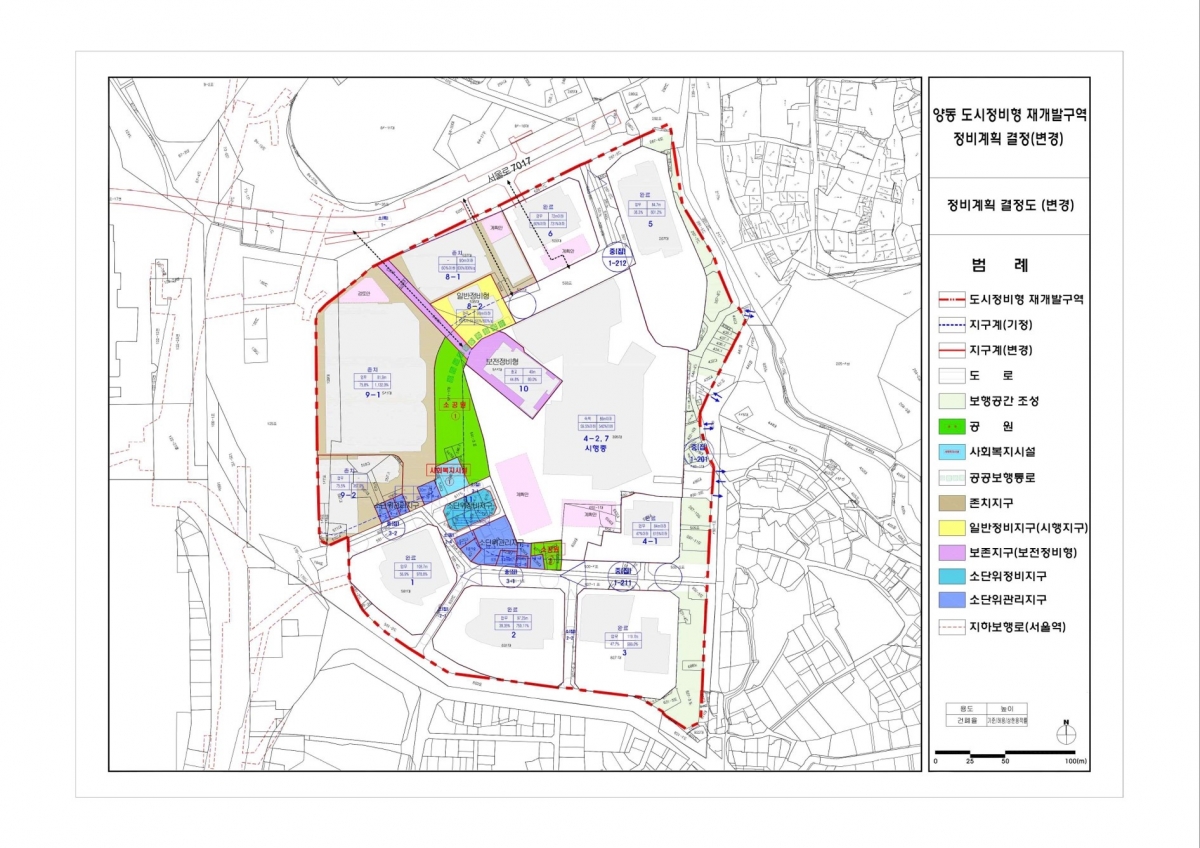
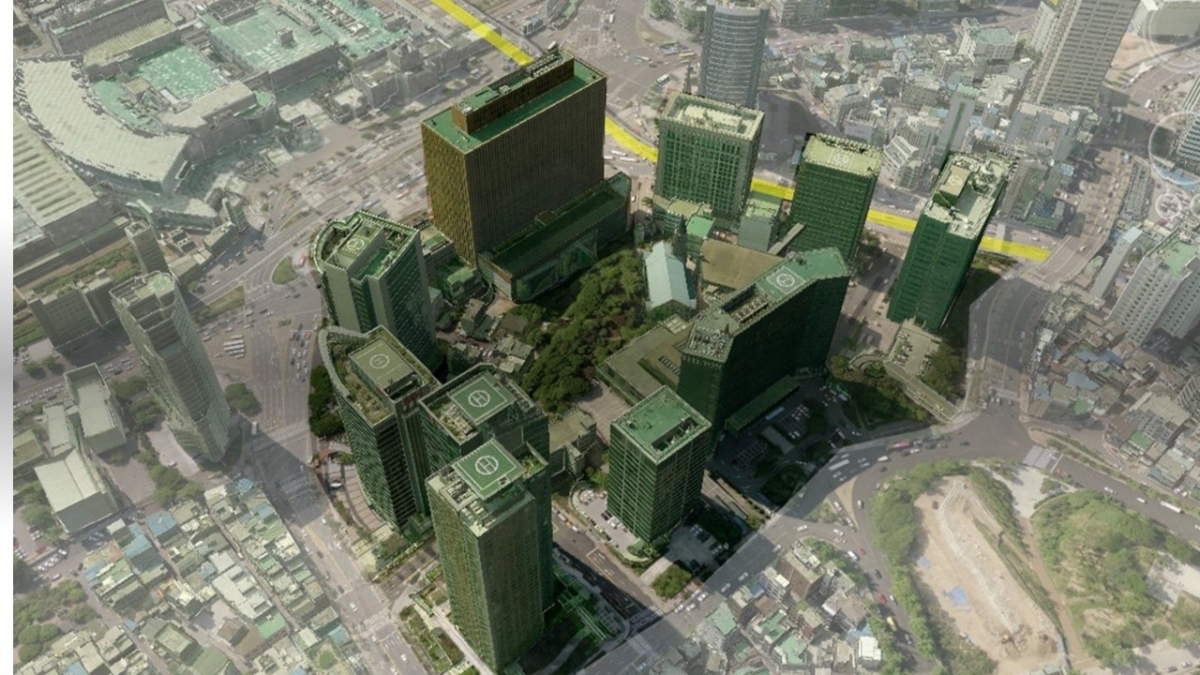
Materials courtesy of Junggu Office
Various Perspectives on the Hilton Hotel
In his presentation ‘The Conservation and Use of Hilton Hotels in the ESG Era’, Kim Saehoon (professor, Seoul National University) expressed concern that a view of development and conservation in a black and white way may oversimplify the balance of power to change the city. In the social aspect, while praising IGIS Asset Management for its efforts to maintain employment of hotel workers in the purchasing process of the Hilton Hotel, he presented the task of creatively incorporating the memories of the people who loved the Hilton Hotel and its architectural and cultural values into the design of new building or remodeling project in the future. In addition, as Lee Kwanghwan mentioned earlier, he recommended that the public sector, the private business operator, and stakeholders should form a governance structure to negotiate the plan and the size of development prior to establishing a development plan so that appropriate public contributions can be made.
Kho Byungki (editor-in-chief, Seoul Property Insight) addressed those assembled with his presentation, ‘A Developer’s Perspective on the City beyond Architecture’. He explained that IGIS Asset Management paid attention to the wider Seoul Station area including the Hilton Hotel and compared it with Tokyo Station’s Marunouchi area regeneration and the Pennsylvania Station area in Manhattan, New York. He said that hotel industry in Korea is at the breaking point, and suggested that a connection by GTX line can also renew the area around Seoul Station through new development.
Sim Kyungmi (research fellow, Architecture & Urban Research Institute), asking the question of who should bear the economic losses caused by the preservation of architectural assets, introduced ʻLocal Architectural Asset Preservation Systemʼ that emphasises its value of use rather than ʻheritageʼ. In conclusion, she argues that it is important to find a way to use and draw upon economic feasibility to preserve the precious works of modern and contemporary architecture.
A Proposal from Kimm Jong-soung, the Architect of the Hilton Hotel
Kimm Jong-soung, architect of the Hilton Hotel, participated in a discussion following the presentations. First, he proposed preservation of the atrium space finished using three or four materials, and the exterior wall assembly that forms the building. He also forged a premise that the structural lifespan of Modernist Architecture could exceed 40 years and even reach 100 years, but the function of the building would change. Therefore, he proposed a plan to transform the current 640 ordinary hotel rooms to upgraded 200 rooms ‒ for example, by converting 3.9m-wide rooms into larger rooms. Of one-and-half or double-width ‒ to make it a five-star hotel. In addition, it is possible to alter the remaining hotel rooms into partitioned offices or high-end studio apartments for professionals, and the ballroom and food and beverage space to become meeting facilities. In addition, he proposed a plan to build office buildings on the site of casino above the parking lot and southwest of the hotel by using the increased floor area ratio up to 800% according to the relieved regulations. In addition, he suggested a macro approach to the Seoul Metropolitan Government so that transfer of air rights can be allowed to hand over the remaining floor area ratio of the Hilton Hotel to adjacent buildings. Next, although residential use is not currently included in the Yangdong Improvement District, he noted that an appropriate size of residential use should be added through amendments to the law, and an organic connection between Seoul Station ‒ Yangdong Improvement District ‒ Namsan axis should be sought by creating a park or underground space. He argued that this is a win-win strategy that would produce profits and preserve architectural culture under a free market economy.
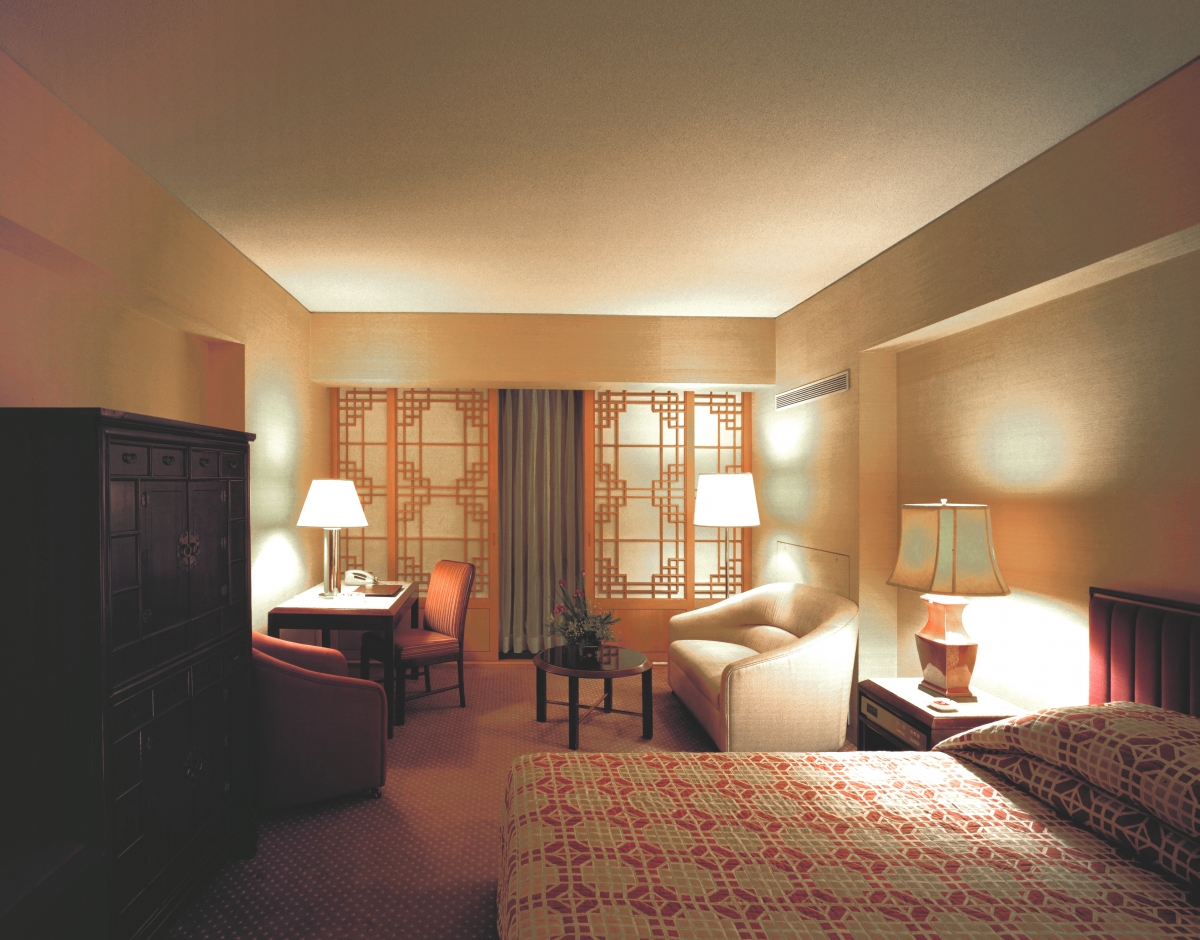
Image courtesy of Art Research Center, National Museum of Modern and Contemporary Art, Korea (Donated by Kimm Jong-soung)
The Future of the Hilton Hotel Depends on its Citizens
Meanwhile, Lee Junghyung (professor, Chungang University), a panelist at the symposium, remarked, ‘I fully agree with the need to preserve technical aspects and details of the Hilton Hotel, but I am wondering whether it is the right solution to keep this building in its current location’. While there are various opinions coursing through the architectural world regarding the use or change of the Hilton Hotel, they generally form a consensus on its architectural value. On the other hand, what do the public think of the Hilton Hotel? Ahn Changmo (professor, Kyonggi University) stressed that inheritance of the Hilton Hotel’s cultural heritage value depends on the actions of the Urban Planning Committee of Seoul, and their power derives from its citizens. However, the architectural world has neglected to share its architectural values with other members of our society. Lee Eunju (journalist, Joongang Ilbo), a panelist at the symposium, also pointed out that our architectural world lacks channels to communicate issues with our society compared to other fields such as contemporary art.
Sim Kyungmi concluded her presentation with a significant statement, ‘I don’t want this event to remain as simply meaningful—I hope it will bear fruit’. In order to bring about substantial change to the future of the Hilton Hotel, we should actively make efforts so that discussion in the architecture sphere does not remain a storm in a teacup but begins to have a felt impact on our society. This will be a matter for many works of modern and contemporary architecture that will follow the fate of the Hilton Hotel.
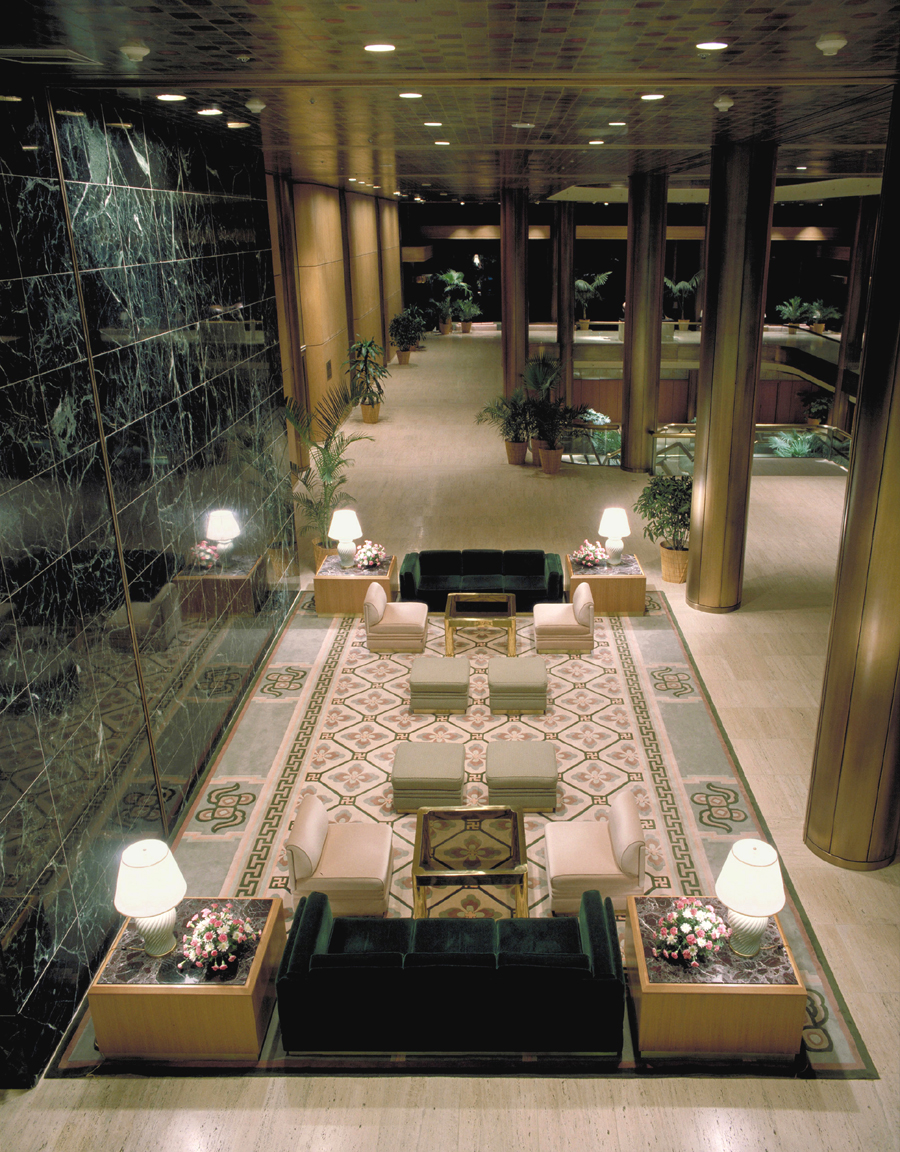
©Lim Chung Eui
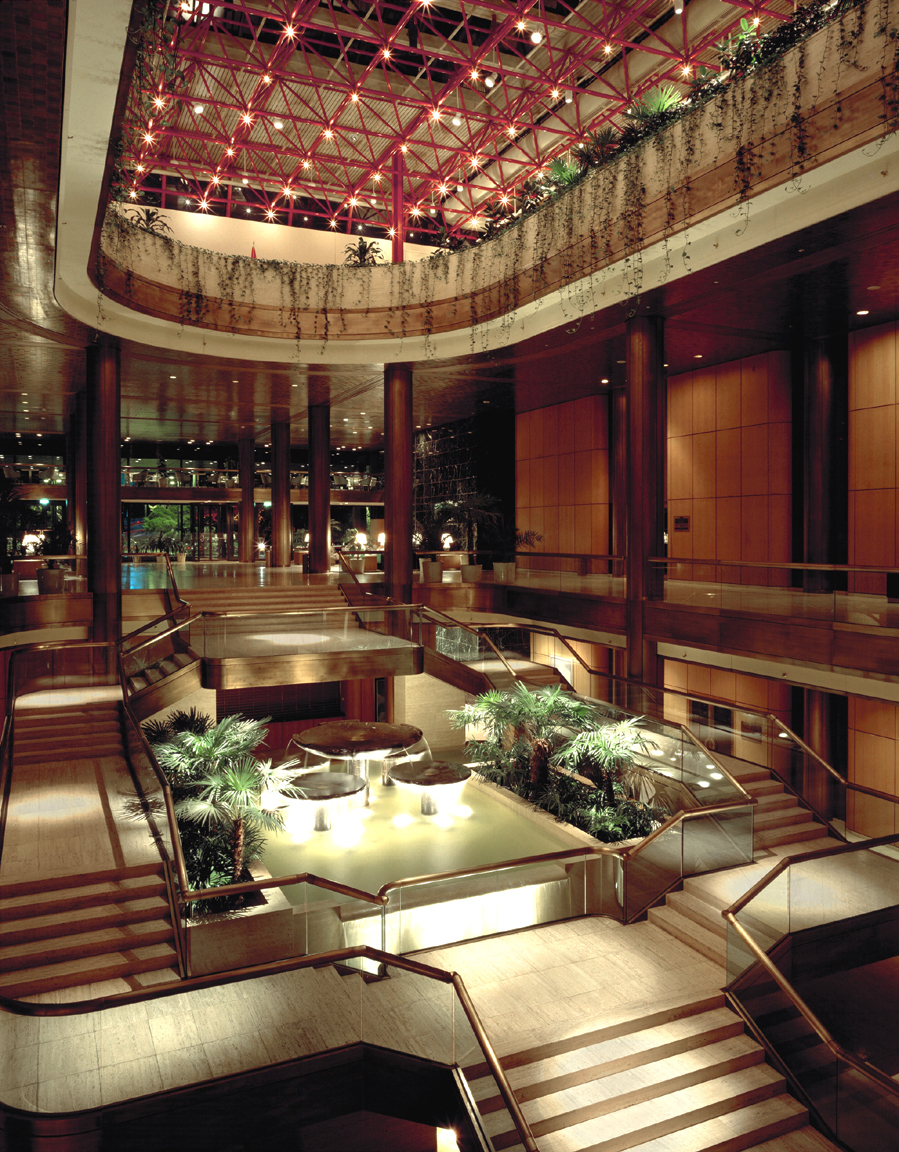
©Lim Chung Eui
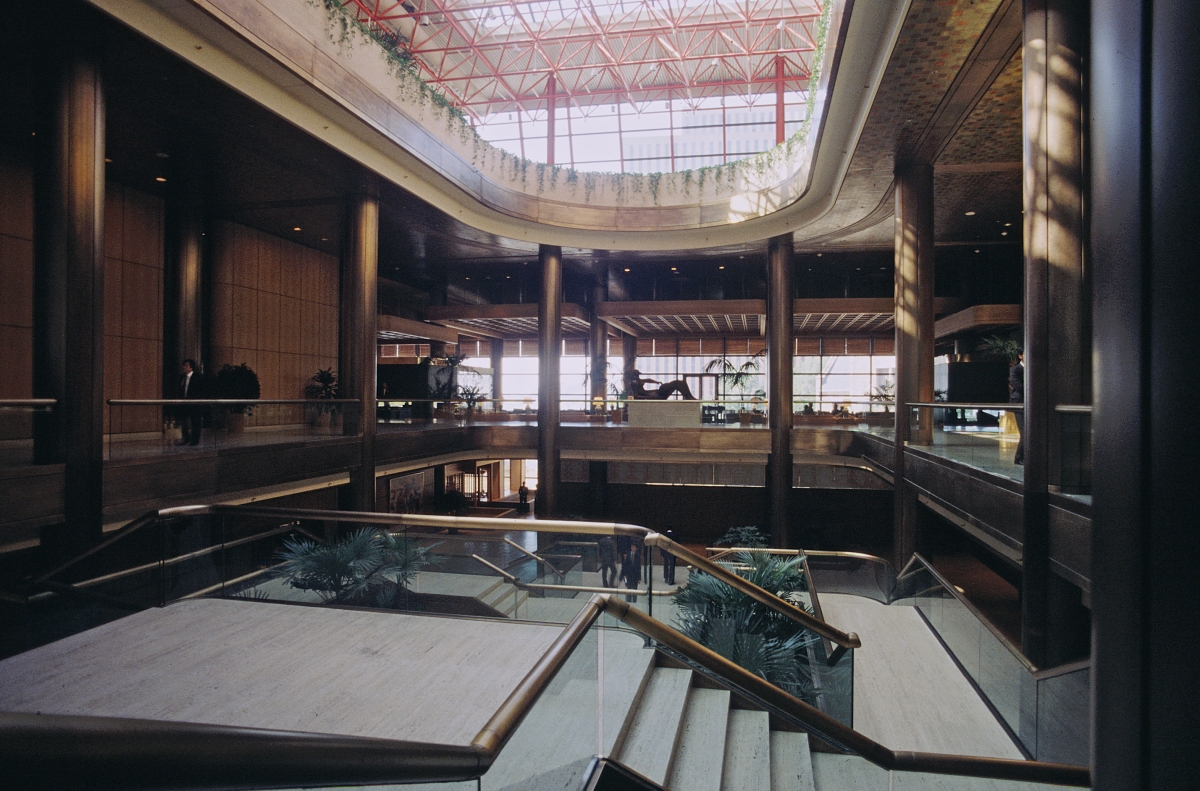
Image courtesy of Art Research Center, National Museum of Modern and Contemporary Art, Korea (Donated by Kimm Jong-soung)
The Position Taken by IGIS Asset Management
On 1st April 2022, there was the opportunity to interview a company official from IGIS Asset Management who were behind the purchase of the Hilton Hotel, and who would be able to speak to the purchase process, the proposed development direction, and their position regarding recent discussions in the architecture world. The meeting was attended by Lee Chulseung (part head, Development Investment Group Investment & Product Dev., IGIS Asset Management), and Song Kiseok (general manager, Development Investment Group Investment & Product Dev., IGIS Asset Management), Kho Byungki (editor-inchief, Seoul Property Insight), Kim Jeoungeun (editor-in-chief, SPACE), Lee Kwanghwan (principal, HAEAHN Architecture), Lim Jinyoung (principal, OPENHOUSE Seoul), and Hwang Doojin (principal, Doojin Hwang Architects). Here, SPACE presents a summary of IGIS Asset Management’s position as discussed in our meeting.
The Background to the Hilton Hotel Purchase and Issues in the Process: A Win-Win for Existing Workers
The Seoul Station area is not one of the top three economic centres in Seoul. It hardly has a significance more than a transit stop. It is not that significant in terms of land pricing, and unfortunately, the area has little land left to develop. It was regrettable that the area hasn’t been activated compared to its importance as the central station of Korea, and the promise of such renewed potential was the starting point for this project. From the point of view of the hotel industry, most hotels that have failed to secure finance are now closing their business. There have been a number of examples in good locations which have been sold to be transformed as accommodation or studio apartments. The Hilton Hotel has also been in trouble. However, as more and more hotels have been closing their business, the issue of existing hotel workers has been spotlit in our society. In the competition to buy the Hilton Hotel, some developers were willing to pay more than us if they didn’t have to consider the existing worker issue. They could make such an approach as they didn’t consider the worker issue, because the hotel would be very popular when it is developed as housing or as studio apartments. However, we considered coexistence with the 420 workers currently employed at the Hilton Hotel as an important
topic. We agreed to solve their employment issue. We have discussed these issues not only with the hotel union affiliated with the Korean Confederation of Trade Unions, but also with individual employees who aren’t the union members. We provided support for job changes or start-ups for those who want to take another leap forward, and we offered a direction for reemployment by guaranteeing employment to those who didnʼt want to stay. We decided to provide an exceptionally large amount of support throughout the entire period of development, and, furthermore, to include a hotel of about 250 rooms in the new building project to ensure re-employment. From our point of view, we tried our best to come up with an ESG solution in the current situation.
Thoughts on Seoul Station-Namsan Mountain: Why IGIS Asset Management Met with Kimm Jong-soung
The spatial structure of a city is greatly influenced by the metropolitan transportation network. In the future, the GTX (Great Train Express) will have a profound impact on Seoul and the wider metropolitan area. Many social issues have arisen from the problem of access to housing, and there is hope that GTX will help lower the entry barrier to home ownership or rental. Housing will spread widely across the metropolitan area, but the office area will be more concentrated, and the biggest centres will of course be placed at Seoul Station and Samseong Station. The area around Samseong Station is splendid and has a high-tech atmosphere filled with highrise buildings. The Seoul Station, meanwhile, is in a slightly different environment. The area should pursue different values. Although it is important in an urban context, it is not the focus of the public attention like Samseong Station. We thought we should create an opportunity in that area. Therefore, we met architect Kimm Jongsoung in November 2021. We thought that his perspective on the area at the time of the Hilton Hotel design would be very helpful. We asked him to create a larger urban context by connecting the then disconnected Seoul Station, Seoullo, and Namsan Mountain. In addition, the architect participated in the Hyundai Global Business Center (GBC), a large-scale complex development at Samseong Station. As such, we thought that he would be the right architect to make this area into one that could better represent Korea while also cultivating a unique charm distinct from Samseong Station.
Thoughts on Architectural Values
Kimm Jong-soung also agreed with the contexts and necessities of what we wanted to create, but we haven’t yet concluded our discussions on the new construction, extension, and renovation of the Hilton Hotel. We also thought a lot about the direction of development in advance from diverse perspectives. Although we understand the architectural value of the Hilton Hotel, we find it impossible to achieve the desired values while also maintaining the hotel building, particularly considering regulations such as the plot shape and floor area ratio, building use, situation of the existing hotel, and contribution to the region. Creating a new context and better value for users requires new planning and design, and new construction is the consequent choice. On the one hand, since private businesses consider predictability important, we could have provided a suitable plan if recent discussions in the architectural world regarding the Hilton Hotel had concluded with a certain prescribed guidelines prior to the purchase. This does not mean that we will not communicate our views on architectural values or cultural issues. We also respect architectural culture. We think that the current agenda in the architectural world is not limited to this building, but is about how best to communicate architectural values to the public. For example, IGIS Asset Management purchased Ssamzigil designed by Choi Moongyu. The building has much less total floor area than that permitted by regulations, but its architectural value has an economic significance. We also considered buying Kim Swoo Geun’s Samtoh Building. We expected that it would lead to a profitable value if we were to make it an attraction for architecture enthusiasts. However, architectural value cannot be calculated according to economic value. We have drawn the most suitable plan at a working level after much deliberation, which is a concern as it may seem as if we are destroying all existing ones. It is feared that many of the contexts surrounding the Hilton Hotel will be removed if we are trapped in an assumed dichotomy of good and evil, which correspond to preservation and demolition respectively. Not merely the architectural value of the Hilton Hotel, but also the social value of stronger communal coexistence with hotel workers and the urban area, and the environmental value of improving the area more generally for citizensʼ use are also important goals for us. If the architectural world comes up with a development plan that is helpful to us while discussing the Hilton Hotel, we will keep listening attentively to their voices. We will also continue thinking about how and what we can contribute with this project as springboard.
Future Plan
At present, in order to select a domestic architectural company, we are preparing OR (ownerʼs requirements) that will meet the current law. In addition, participating companies will be asked for ideas to promote the Hilton Hotel’s value. We don’t think originality derives from form alone. For example, an old brand doesnʼt have to keep its original form as it was a few decades ago. We also think that architectural value can contribute to business value to some degree. After a domestic architectural company is selected, an international invited design competition will be held to address worldclass architects, and video platforms will be provided to communicate this process with the public. In this way, we will refer to architectsʼ ideas and discuss how they can be implemented from an urban point of view. We will not simply ask them to build our building but will discuss how best to transform undervalued areas around Seoul Station and Namsan Mountain. We hope that you will be eager to see the fruits of our sincere participation and communication adopting an open mind and a positive perspective.




